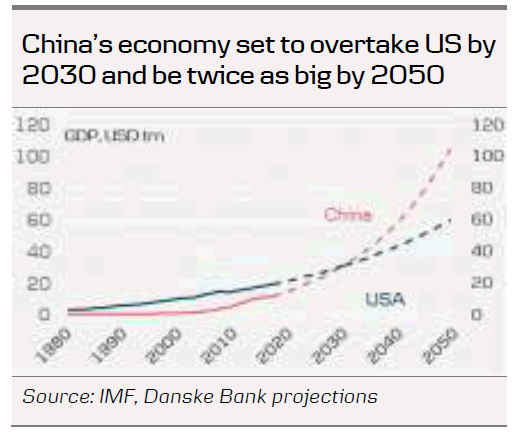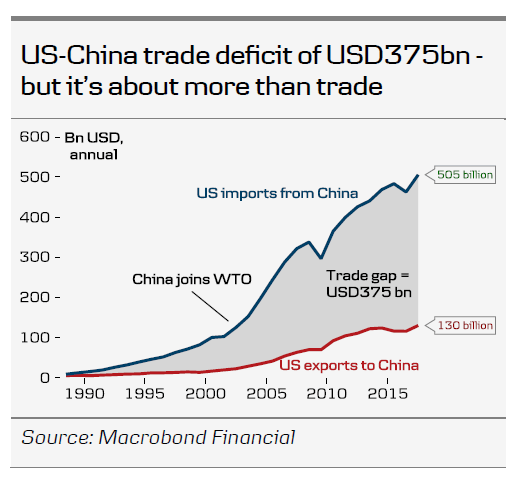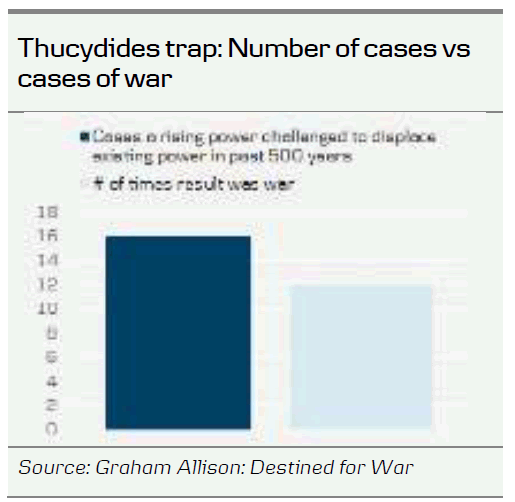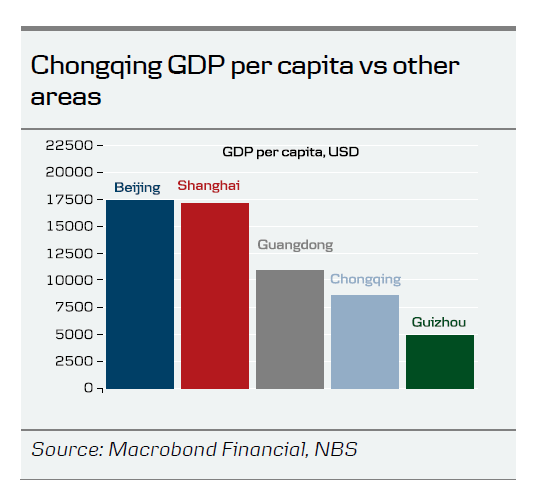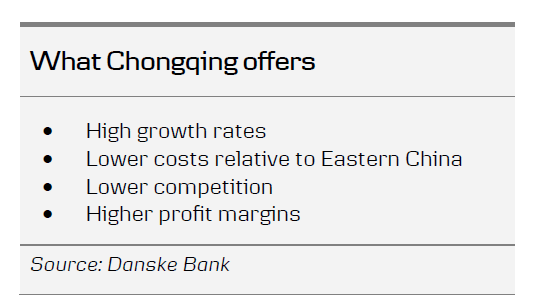I have just returned from a trip to China on a fact-finding mission to gain a better understanding of the world’s second-largest economy. I travelled with Mathias Boyer from our representative office in Beijing. He grew up in China and understands the Chinese mindset better than most people I know. Below are the key takeaways from our round trip.
- The US-China trade war is here to stay. Further escalation is likely and a deal is not in sight in the near future. 2018 marks the beginning of a new confrontational path in a strategic long-term rivalry between the US and China.
- A visit to Chongqing revealed an area with plenty of opportunities for Nordic companies: High growth and lower costs and competition than on the east coast.
- The city of Guiyang in one of the poorest provinces of China, Guizhou, is going through a rapid development after being selected as the new hub for data centres and cloud technology.
Beijing: trade war high on the agenda
Clearly, the US-China trade war is at the top of the agenda in many talks. A clear takeaway from our discussions was that China now sees the US tariffs as a US containment strategy aimed at holding China back. Initially, China saw the trade frictions as mostly about trade and their leaders saw a deal within reach when negotiations started in April. However, since late May when the US left the negotiating table, China sees things differently: the US wants to keep China from outgrowing the US by climbing the technological ladder and wants China to stop its Made in China 2025 strategy. This is unacceptable to China. The Chinese leadership has taken several steps this year to open up China further and increase protection of property rights, but it will not dismantle a technology strategy that it sees as necessary to avoid being caught in the ‘middle income trap’. GDP per capita in China is only 15% that of the US level and despite decades of urbanisation, China still has close to 600m people living in rural areas with a fairly low income. The US on the other side seems to want to keep pushing China by raising tariffs further to make China cave in. This is leaving the trade war in a deadlock, at least for now.
China is preparing for a long trade war and is taking steps to adapt to the new situation. It is the belief that although the US looks strong now, it will not be so forever and President Trump will eventually have to get to the negotiating table. More tariffs would also hurt the US and when the fiscal stimulus fades again, Trump’s hand would weaken.
Our own expectation is that Trump will eventually make a deal as the cost for US businesses will mount over time. However, we think it is likely to get worse before it gets better and a deal is not within reach until well into 2019. The risk is that it drags out for longer.
For Nordic companies the trade war will have a range of implications – both positive and negative. First, China’s position as a production centre has become more uncertain if part of the production is exported to the US. Even if we get a deal next year, it cannot be ruled out that a trade war may return again in the future. There are already reports that the trade war has led some companies to move production away from China, see SCMP, as the tariffs are only adding to arguments for companies that see rising costs in China and are looking to other parts of Asia for future production. Second, there are also benefits for Nordic companies. Exporters to China will have a competitive benefit relative to US competitors in the Chinese market that face tariffs when crossing the Chinese border. At the same time, Nordic companies benefit from Chinese steps towards opening up faster and reduced protection of their own companies – because of the external pressure from Trump. Hence, it is not all bad for EU and Nordic companies.
The Thucydides Trap – a theme entering more discussions
There is broad agreement that even if we have a trade deal next year, 2018 will mark the beginning of a sharp turn in the US-China relationship towards a long-term strategic rivalry. Trump is far from alone in the US in taking a much tougher stance on China. A competition has begun between an existing super power, the US, which has been a super power through most of the nation’s existence, and a rising super power, China, which will likely overtake the US in the coming decades and return to its previous status as the world’s single largest economic power. It is a rivalry that will likely involve a technological race as well as occasional military frictions in the South China Sea and/or around Taiwan.
The Thucydides trap has become an increasing focus point when discussing US-China relations and pops up in most discussions of what the rivalry means. The trap is named after the Greek historian Thucydides who explained that: “It was the rise of Athens and the fear that this instilled in Sparta that made war inevitable.” Harvard professor Graham Allison has become famous for his analysis of this so-called Thucydides trap. In his book Destined for War, he looks into 16 cases over the past 500 years in which a rising power threatened to displace a ruling one. In 12 of these cases, it ended in war (for a brief overview see his article in Foreign Policy last year).
Fortunately, Allison also mentions conditions that speak in favour of this scenario being avoided today for the US and China, with the nuclear deterrent being the most significant. However, it is likely to be the largest global security issue in the coming decades with China’s economy set to be double the size of the US economy by around 2050E. Given China’s large population of 1.4bn people – four times the size of the US – it merely requires that China reaches a GDP per capita of half of the US’. This corresponds to the level that countries like Spain and Italy are at today and should be in reach for China.
Chongqing: high growth, low production costs and less competition are features of the ‘Wild West’
Fortunately, our trip also had more uplifting moments than discussing the outlook for longterm strategic rivalry. A visit to Chongqing revealed that China’s growth is not only centred on the east coast but is also increasingly spreading into the country. While Chongqing is little known outside of China, it is a city with a population of 12m and is located in the western part of China in Sichuan Province. The entire Chongqing Municipality covers an area twice the size of Denmark and has a population of 32m – about double the population of Scandinavia. We visited the Investment Promotion Centre and one of the few Danish companies there. Chongqing has only about half the GDP per capita of the big cities on the east coast such as Shanghai and Beijing. Nevertheless, a key takeaway from the visit was that there are many opportunities in this region for Nordic companies
First, the western part of China is in a phase of catching up with the east coast and has plenty of support from the government. It means that growth rates are high and the middle class is growing strongly. The need for ‘green solutions’ also has a high priority. Second, production costs are only half what they are on the east coast because wages are much lower and office and production space cheaper.
Third, competition is much more limited than in the richer areas where most foreign companies moved to first. Lower competition means higher profit margins and implies that it is easier to get a fair share of the market. The company we talked to is in the top five in the region but would only be in the top 25 on the east coast.
Fourth, the local government is hungrier to attract foreign companies that can contribute to the development of the region compared with the eastern part of China, where companies have already flocked to. It means foreign companies can apply for subsidies of up to CNY30bn, depending on the size of the company. As a new Free Trade Zone area, Chongqing has also opened up for foreign investment in more areas.
A headwind for the western part of China is more expensive transport costs. This goes a long way to understanding the economic reasoning behind the Belt & Road Initiative (BRI). Connecting the western part of China with Europe is key for developing this area. In 2011 (actually before the launch of the BRI in 2013), a rail link from Chongqing to Xinjian to Europe was opened. The transportation cost of rail is higher than maritime shipping, but on the positive side, the transportation time is shorter. It typical takes 13-15 days to reach Europe by train compared to 40-50 days by sea. The cost is still three times higher, though.
Chongqing has one-third of the world’s production of computers and tablets and is significant in terms of production of mobile phones. Technology has a high priority, while the consumer sector and financial services are also key focus areas.
We left Chongqing with a new perspective on the potential in this region. Not many Nordic companies have found their way to Western China, but from our point of view, it is definitely a region worth considering if entering China for the first time and also for those companies only established on the east coast.
Guiyang: China’s new hub for data storage and cloud technology
Our trip continued to Guiyang, the capital of the South Western province of Guizhou, one of the poorest provinces in China. Guiyang has been through an amazing development since the government decided four years ago that the city should be a centre for big data and made it the first big data pilot zone. As cooling represents 80% of the cost of data centres, the cool climate in Guiyang makes it perfect for this industry. As usual when the Chinese government makes a push into a new area, the development moved very quickly. Five years ago, Guiyang had less than 1,000 big data companies and now has about 8,900. Guiyang has had some of the highest growth rates in China in recent years and we witnessed a city that looks modern but is also still in the process of expanding. Increasingly more companies, such as Huawei, Google, IBM and Apple, are cooperating with Guiyang, taking advantage of the rising cluster of knowhow and favourable conditions for cooling.
A visit to the exhibition centre revealed an impressive development within data storage and cloud technology. With a population of 1.4bn and big data being a strong growth area, Guiyang seems destined to have lots of potential within data storage. It is a good example in our view of how China utilises the comparative advantage of an area that is not suitable for a lot of manufacturing production, given the mountainous geography and higher transport costs to both the railway belt to Europe and shipping to other parts of the world
It is a way of bringing development into the country. We visited a data centre and saw with our own eyes how the data storage facilities are expanding at a high speed and constantly improving the technology in this field. Research and development is high on the agenda and cooperation with universities is widespread to innovate and train more engineers for the industry. The visit served as an example for us of China’s ambitions in technology and what it is capable of when it mobilises resources and collaborates with the relevant institutions to develop an industry. Illustrating the potential, Alibaba president Jack Ma highlighted the following: “If you missed the opportunity in Guangdong and Zheijiang 30 years ago, don’t miss Guizhou today.”
Conclusion: many opportunities in China – despite trade war
As usual it was a fruitful trip to China and our key takeaway is that while the world may have become more uncertain, the rise of China also still offers plenty of opportunities – and increasingly so in the western part of the country.




